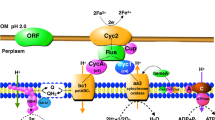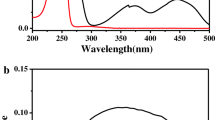Abstract
Effect of water-soluble and stable sucrose-bound iron oxyhydroxide nanoparticles [Fe[III] sucrose complex (FSC)] on the efficiency of electron transport in the photosystem II membranes was studied. FSC significantly increases (by a factor 1.5) the rate of light-induced oxygen evolution in the presence of alternative electron acceptor 2,6-dichloro-p-benzoquinone (DCBQ). Without DCBQ, FSC only slightly (5%) provides the oxygen evolution. Electron transport supported by pair DCBQ + FSC is inhibited by diuron. Maximum of stimulating effect was recorded at Fe(III) concentration 5 µM. In the case of another benzoquinone electron acceptor (2-phenyl-p-benzoquinone and 2,3-dimethyl-p-benzoquinone) and 2,6-dichlorophenolindophenol, stimulating effect of FSC was not observed. Incubation of PSII membranes at different concentrations with FSC is accompanied by binding of Fe(III) by membrane components but only about 50% of iron can be extracted by membranes from Fe(III) solution at pH 6.5. This result implies the heterogeneity of FSC solution in a buffer. The heterogeneity depends on pH and decreases with its rising. At pH around 9.0 Fe(III), sucrose solution is homogeneous. The study of pH effect has shown that stimulation of electron transport is induced only by iron cations which can be bound by membranes. Not extractable iron pool cannot activate electron transfer from oxygen-evolving complex to DCBQ.







Similar content being viewed by others
Abbreviations
- BPDS:
-
Bathophenanthroline disulfonic acid
- Chl:
-
Chlorophyll
- DCMU:
-
3-(3,4-Dichlorophenyl)-1,1-dimethylurea
- DCBQ:
-
2,6-Dichloro-p-benzoquinone
- DCPIP:
-
2,6-Dichlorophenolindophenol
- DMBQ:
-
2,3-Dimethyl-p-benzoquinone
- HEPES:
-
N-2-hydroxyethylpiperazine-N′-2-ethanesulfonic acid
- FSC:
-
Fe(III) sucrose complex
- MES:
-
2-(N-morpholino)-ethanesulfonic acid
- OEC:
-
Oxygen-evolving complex
- PQ:
-
Plastoquinone
- PPBQ:
-
2-Phenyl-p-benzoquinone
- PSII:
-
Photosystem II
- PSII(-Ca):
-
Ca2+-depleted PSII membranes
- RC:
-
Reaction center
- Tris:
-
Tris(hydroxymethyl)aminomethane
References
Barot BS, Parejiya PB, Mehta DM, Shelat PK, Shah GB (2014) Physicochemical and structural characterization of iron–sucrose formulations: a comparative study. Pharm Dev Technol 19:513–520. https://doi.org/10.3109/10837450.2013.7951171
Cardona T, Sedoud A, Cox N, Rutherford AW (2012) Charge separation in photosystem II: a comparative and evolutionary overview. Biochim Biophys Acta 1817:26–43
Charley PJ, Sarkar B, Stitt CF, Saltman P (1963) Chelation of iron by sugars. Biochim Biophys Acta 69:313–321
Coe EM, Bowen LH, Speer JA, Wang Z, Sayers DE, Bereman RD (1995) The recharacterization of a polysaccharide iron complex (Niferex). J Inorg Biochem 58(4):269–278
de Wijn R, van Gorkom HJ (2001) Kinetics of electron transfer from QA to QB in photosystem II. Biochemistry 40:11912–11922. https://doi.org/10.1021/bi010852r
Eckhardt U, Buckhout TJ (1998) Iron assimilation in Chlamydomonas reinhardtii involves ferric reduction and is similar to strategy I higher plants. J Exp Bot 49:1219–1226
Ghanotakis DF, Babcock GT (1983) Hydroxylamine as an inhibitor between Z and P680 in photosystem II. FEBS Lett 153:231–234
Ghanotakis DF, Babcock GT, Yocum CF (1984) Structural and catalytic properties of the oxygen-evolving complex. Correlation of polypeptide and manganese release with the behavior of Z in chloroplasts and a highly resolved preparation of the PSII complex. Biochim Biophys Acta 765:388–398
Haumann M, Liebisch P, Muller C, Barra M, Grabolle M, Dau H (2005) Photosynthetic O2 formation tracked by time-resolved X ray experiments. Science 310:1019–1021
Ito H, Kondo R, Yoshimori K, Kamachi T (2018) Methane hydroxylation with water as an electron donor under light irradiation in the presence of reconstituted membranes containing both photosystem II and a methane monooxygenase. Chem Bio Chem 19:2152–2155
Jahn MR, Andreasen HB, Fütterer S, Nawroth T, Schünemann V, Kolb U, Hofmeister W, Mucoz M, Bock K, Meldal M, Langguth P (2011) A comparative study of the physicochemical properties of iron isomaltoside 1000 (Monofer), a new intravenous iron preparation and its clinical implications. Eur J Pharm Biopharm 78:480–491
Karge O, Bondar A-N, Dau H (2014) Cationic screening of charged surface groups (carboxylates) affects electron transfer steps in photosystem-II water oxidation and quinone reduction. Biochim Biophys Acta 1837:1625–1634
Kern J, Tran R, Alonso-Mori R, Koroidov S, Echols N, Hattne J et al (2014) Taking snapshots of photosynthetic water oxidation using femtosecond X-ray diffraction and spectroscopy. Nat Commun 5:4371. https://doi.org/10.1038/ncomms5371
Khan S, Sun JS, Brudvig GW (2015) Cation effects on the electron-acceptor side of photosystem II. J Phys Chem B 119:7722–7728
Krieger A, Weis W (1992) Energy-dependent quenching of chlorophyll-a-fluorescence: the involvement of proton-calcium exchange at photosystem 2. Photosynthetica 27:89–98
Kudasheva DS, Lai J, Ulman A, Cowman MK (2004) Structure of carbohydrate-bound polynuclear iron oxyhydroxide nanoparticles in parenteral formulations. J Inorg Biochem 98:1757–1769
Loktyushkin AV, Lovyagina ER, Semin BK (2018) Inhibition of photosystem II electron-transport chain by terbium ions. Russ J Biol Phys Chem 3(2):250–255
McCauley SW, Melis A (1986) Quantitation of photosystem II in spinach chloroplasts. Biochim Biophys Acta 849:175–182. https://doi.org/10.1016/0005-2728(86)90023-X
Mersch D, Lee CY, Zhang JZ, Brinkert K, Fontecilla-Camps JC, Rutherford AW, Reisner E (2015) Wiring of photosystem II to hydrogenase for photoelectrochemical water splitting. J Am Chem Soc 137(26):8541–8549. https://doi.org/10.1021/jacs.5b03737
Müh F, Glöckner C, Hellmich J, Zouni A (2012) Light-induced quinone reduction in photosystem II. Biochim Biophys Acta 1817:44–65
Ono T, Inoue Y (1990) Abnormal redox reactions in photosynthetic O2-evolving centers in NaCl/EDTA-washed PS II. A dark-stable EPR multiline signal and an unknown positive charge accumulator. Biochim Biophys Acta 1020:269–277
Petrouleas V, Diner BA (1987) Light-induced oxidation of the acceptor-side Fe(II) of photosystem II by exogenous quinones acting through the Q B binding site. I. Quinones, kinetics and pH-dependence. Biochim Biophys Acta 893:126–137. https://doi.org/10.1016/0005-2728(87)90032-6
Petrova A, Mamedov M, Ivanov B, Semenov A, Kozuleva M (2018) Effect of artificial redox mediators on the photoinduced oxygen reduction by photosystem I complexes. Photosynth Res 137:421–429. https://doi.org/10.1007/s11120-018-0514-z
Porra RJ, Tompson WA, Kriedemann PE (1989) Determination of accurate extinction coefficients and simultaneous-equations for assaying chlorophyll-A and chlorophyll-B extracted with 4 different solvents—verification of the concentration of chlorophyll standards by atomic-absorption spectroscopy. Biochim Biophys Acta 975:384–394
Romslo I, Flatmark T (1973) Energy-dependent accumulation of iron by isolated rat liver mitochondria. Biochim Biophys Acta 305:29–40. https://doi.org/10.1016/0005-2728(73)90228-4
Roose JL, Frankel LK, Bricker TM (2010) Documentation of significant electron transport defects on the reducing side of photosystem II upon removal of the PsbP and PsbQ extrinsic proteins. Biochemistry 49:36–41
Semin BK, Seibert M (2004) Iron bound to the high-affinity Mn-binding site of the oxygen-evolving complex shifts the pK of a component controlling electron transport via Y(Z). Biochemistry 43:6772–6782
Semin BK, Seibert M (2006) A carboxylic residue at the high-affinity, Mn-binding site participates in the binding of iron cations that block the site. Biochim Biophys Acta 1757:189–197
Semin BK, Seibert M (2016) Substituting Fe for two of the four Mn ions in photosystem II—effects on water-oxidation. J Bioenerg Biomembr 48:227–240. https://doi.org/10.1007/s10863-016-9651-2
Semin BK, Ivanov II, Rubin AB, Parak F (1995) High-specific binding of Fe(II) at the Mn-binding site in Mn-depleted PSII membranes from spinach. FEBS Lett 375:223–226
Semin BK, Ghirardi ML, Seibert M (2002) Blocking of electron donation by Mn(II) to YZ· following incubation of Mn-depleted photosystem II membranes with Fe(II) in the light. Biochemistry 41:5854–5864
Semin BK, Davletshina LN, Seibert M, Rubin AB (2018a) Creation of a 3Mn/1Fe cluster in the oxygen-evolving complex of photosystem II and investigation of its functional activity. J Photochem Photobiol B 178:192–200
Semin BK, Davletshina LN, Mamedov MD (2018b) Effect of different methods of Ca2+ extraction from PSII oxygen evolving complex on the Q −A oxidation kinetics. Photosynth Res 136:83–91. https://doi.org/10.1007/s11120-017-0441-4
Suga M, Akita F, Hirata K, Ueno G, Murakami H, Nakajima Y, Shimizu T, Yamashita K, Yamamoto M, Ago H, Shen J-R (2015) Native structure of photosystem II at 1.95 Å resolution viewed by femtosecond X-ray pulses. Nature 517:99–103. https://doi.org/10.1038/nature13991
Tighe-Neiraa R, Carmorac E, Recioc G, Nunes-Nesid A, Reyes-Diaze M, Alberdie M, Rengelg Z, Inostroza-Blancheteaub C (2018) Metallic nanoparticles influence the structure and function of the photosynthetic apparatus in plants. Plant Physiol Biochem 130:408–417
Touloupakis E, Giannoudi L, Piletsky SA, Guzzella L, Pozzoni F, Giardi MT (2005) A multi-biosensor based on immobilized photosystem II on screen-printed electrodes for the detection of herbicides in river water. Biosens Bioelectron 20:1984–1992
Ulas G, Brudvig GW (2011) Redirecting electron transfer in photosystem II from water to redox-active metal complexes. J Am Chem Soc 133:13260–13263. https://doi.org/10.1021/ja2049226
Umena Y, Kawakami K, Shen J-R, Kamiya N (2011) Crystal structure of oxygen-evolving photosystem II at a resolution of 1.9 Å. Nature 473:55–60. https://doi.org/10.1038/nature09913
Wiwczar J, Brudvig GW (2017) Alternative electron acceptors for photosystem II. In: Hou HJM et al (eds) Photosynthesis: structures, mechanisms, and applications. Springer, Cham, pp 51–66. https://doi.org/10.1007/978-3-319-48873-8_4
Wu Y, Petrochenko P, Chen L, Wong SY, Absar M, Choi S, Zheng J (2016) Core size determination and structural characterization of intravenous iron complexes by cryogenic transmission electron microscopy. Int J Pharm 505:167–174
Xu Q, Bricker TM (1992) Structural organization of proteins on the oxidizing side of photosystem II. Two molecules of the 33-kDa manganese-stabilizing proteins per reaction center. J Biol Chem 267:25816–25821
Young ID, Ibrahim M, Chatterjee R, Gul S, Fuller FD, Koroidov S et al (2016) Structure of photosystem II and substrate binding at room temperature. Nature 540:453–457
Acknowledgements
We are very grateful to Dr. Kholina E.G. for helping in the measurement of zeta potential.
Author information
Authors and Affiliations
Corresponding author
Additional information
Publisher's Note
Springer Nature remains neutral with regard to jurisdictional claims in published maps and institutional affiliations.
Rights and permissions
About this article
Cite this article
Semin, B.К., Davletshina, L.N. & Rubin, A.B. Effect of sucrose-bound polynuclear iron oxyhydroxide nanoparticles on the efficiency of electron transport in the photosystem II membranes. Photosynth Res 142, 57–67 (2019). https://doi.org/10.1007/s11120-019-00647-4
Received:
Accepted:
Published:
Issue Date:
DOI: https://doi.org/10.1007/s11120-019-00647-4




